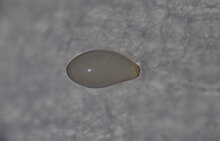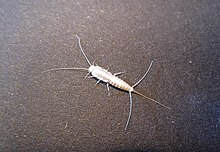Ghost fish
| Ghost fish | ||||||||||||
|---|---|---|---|---|---|---|---|---|---|---|---|---|

Ghostfish ( Ctenolepisma calva ) in Chemnitz, 2017 |
||||||||||||
| Systematics | ||||||||||||
|
||||||||||||
| Scientific name | ||||||||||||
| Ctenolepisma calva | ||||||||||||
| ( Ritter , 1910) |
Ghostfish ( Ctenolepisma calva ) are a species of wingless, scaled insects of tropical origin from the family Lepismatidae, which also includes the better known silverfish .
description
The species reaches a body length of eight millimeters. It has the typical, spindle-shaped body shape of the fish, with this species the outline is narrow, almost parallel when viewed from above. The body is yellowish white in color and dense, light brown scales. The antennae are approximately the length of the body. The lower jaw probes are five-part, the lip probes only four-part, with a disc-shaped widened end member. The small complex eyes each consist of eight ommatidia . The pronotum of the trunk section is cut in a semicircle at the front to accommodate the head. On the abdomen are two pairs of styli (articulated appendices that go back to the limb structures). The three tail appendages are of unequal length: the middle one, the terminal filum, is longer than the antennae, the two lateral cerci reach about two thirds of the body length. In addition to the scaling, the body has some bristles which, as in the related species, are pinnate (i.e. each bristle has a border of smaller, protruding hairs). What is striking is a tufted group of bristles on both sides of the deflection of the antennae.
The species can be distinguished from related species in the following characteristics: The ovipositor of the female is very long, it protrudes far beyond the end of the abdomen, it has bristles on the side. The nota of the fuselage section only have a small bristle on each side at the rear edge, no bristle combs made up of several bristles of equal strength.
distribution
The species was discovered in Colombo on Ceylon by the Czech entomologist Jindřich Uzel and described by Wolfgang Ritter in 1910 . He described a new genus Peliolepisma for this species . The genus was later synonymous with the genus Ctenolepisma by Jiří Paclt . After that the species was discovered in America, where it occurs exclusively synanthropically in houses. There are finds from Guyana and Cuba , where it is said to be quite common in the capital Havana . The American finds probably go back to human introduction.
In 2017 they were discovered for the first time in Europe, in Chemnitz , among others in the local Museum of Natural History . In the press release issued for this, the common name “ghost fish” was re-coined.
Web links
- Tropical ghost fish conquers Germany Press release June 2, 2017 (PDF document)
Individual evidence
- ↑ a b Wolfgang Ritter: New Thysanurs and Collembola from Ceylon and Bombay, collected by Dr. Uzel. Annals of the Natural History Museum in Vienna 24 (3/4), 1910–1911, pp. 379–398.
- ^ A b Pedro Wygodzinsky: A Review of the Silverfish (Lepismatidae, Thysanura) of the United States and the Caribbean Area. American Museum Novitates 2481, 1972. 25 pages.
- ^ Aliens among us - an encounter with the sixth kind of press release of the city of Chemnitz from April 7th, 2017. by Sven Erlacher, Museum für Naturkunde Chemnitz.

